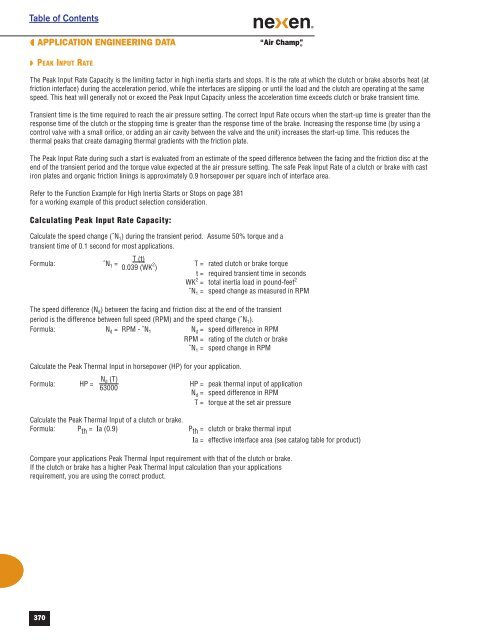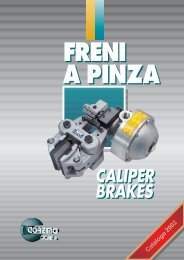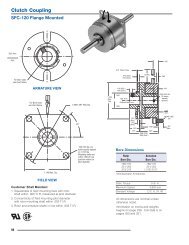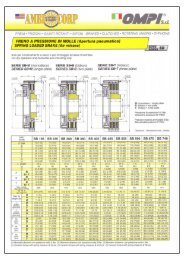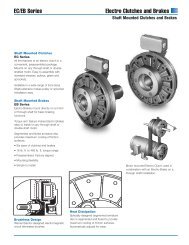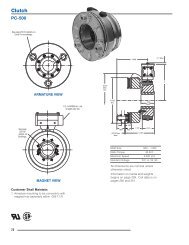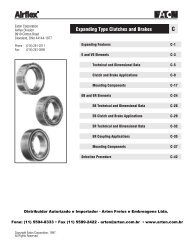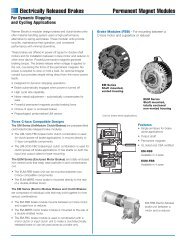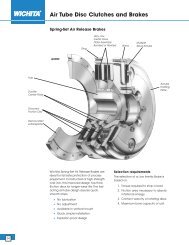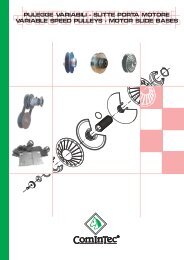- Page 1:
Table of ContentsPRODUCTCAT ALOG10-
- Page 4 and 5:
Table of Contents◗PRODUCT NUMBER
- Page 6 and 7:
Table of Contents◗PRODUCT NUMBER
- Page 8:
Table of Contents◗PRODUCT NUMBER
- Page 12 and 13:
Table of Contents◗FAMILY OF PRODU
- Page 16:
Table of Contents◗FAMILY OF PRODU
- Page 19:
Table of Contents“Air Champ” ®
- Page 24:
Table of Contents◗APPLICATION GUI
- Page 27 and 28:
Table of ContentsWeb ProductsGUIDE
- Page 29 and 30:
Table of Contents“Air Champ” ®
- Page 31 and 32:
Table of Contents◗ MICRO FRICTION
- Page 33 and 34:
Table of Contents“Air Champ” ®
- Page 35 and 36:
Table of Contents“Air Champ” ®
- Page 37 and 38:
Table of Contents“Air Champ” ®
- Page 39 and 40:
Table of Contents“Air Champ” ®
- Page 41 and 42:
Table of Contents“Air Champ” ®
- Page 43 and 44:
Table of Contents“Air Champ” ®
- Page 45 and 46:
Table of Contents“Air Champ” ®
- Page 47 and 48:
Table of Contents“Air Champ” ®
- Page 49 and 50:
Table of Contents“Air Champ” ®
- Page 51 and 52:
Table of Contents“Air Champ” ®
- Page 53 and 54:
Table of Contents“Air Champ” ®
- Page 55 and 56:
Table of Contents“Air Champ” ®
- Page 57 and 58:
Table of Contents◗“Air Champ”
- Page 59 and 60:
Table of Contents“Air Champ” ®
- Page 61 and 62:
Table of Contents“Air Champ” ®
- Page 63 and 64:
Table of Contents“Air Champ” ®
- Page 65 and 66:
Table of Contents“Air Champ” ®
- Page 67 and 68:
Table of Contents“Air Champ” ®
- Page 69 and 70:
Table of ContentsWeb ProductsIn acc
- Page 71 and 72:
Table of ContentsWeb ProductsTENSIO
- Page 73 and 74:
Table of ContentsWeb ProductsHousin
- Page 75 and 76:
Table of ContentsWeb ProductsTENSIO
- Page 77 and 78:
Table of ContentsWeb ProductsTENSIO
- Page 79 and 80:
Table of Contents“Air Champ” ®
- Page 81 and 82:
Table of Contents“Air Champ” ®
- Page 83 and 84:
Table of Contents“Air Champ” ®
- Page 85 and 86:
Table of Contents“Air Champ” ®
- Page 87 and 88:
Table of Contents“Air Champ” ®
- Page 89 and 90:
Table of Contents“Air Champ” ®
- Page 91 and 92:
Table of Contents“Air Champ” ®
- Page 93 and 94:
Table of Contents“Air Champ” ®
- Page 95 and 96:
Table of Contents“Air Champ” ®
- Page 97 and 98:
Table of Contents“Air Champ” ®
- Page 99 and 100:
Table of Contents“Air Champ” ®
- Page 103 and 104:
Table of Contents“Air Champ” ®
- Page 105 and 106:
Table of Contents“Air Champ” ®
- Page 107 and 108:
Table of Contents“Air Champ” ®
- Page 109 and 110:
Table of Contents“Air Champ” ®
- Page 111 and 112:
Table of Contents◗ AIR PRESSURE C
- Page 113 and 114:
Table of Contents“Air Champ” ®
- Page 115 and 116:
Table of Contents“Air Champ” ®
- Page 117 and 118:
Table of Contents“Air Champ” ®
- Page 119 and 120:
Table of Contents“Air Champ” ®
- Page 121 and 122:
Table of Contents“Air Champ” ®
- Page 123 and 124:
Table of Contents“Air Champ” ®
- Page 125 and 126:
Table of Contents“Air Champ” ®
- Page 127 and 128:
Table of ContentsEclipse SERVOMOTOR
- Page 129 and 130:
Table of ContentsEclipse SERVOMOTOR
- Page 131 and 132:
Table of ContentsEclipse LINEAR MOT
- Page 133 and 134:
Table of ContentsEclipse NEMA AC MO
- Page 135 and 136:
Table of ContentsEclipse METRIC AC
- Page 137 and 138:
Table of Contents◗ BW MODEL BRAKE
- Page 139 and 140:
Table of Contents“Air Champ” ®
- Page 141 and 142:
Table of Contents“Air Champ” ®
- Page 143 and 144:
Table of Contents“Air Champ” ®
- Page 145 and 146:
Table of Contents“Air Champ” ®
- Page 147 and 148:
Table of Contents“Air Champ” ®
- Page 149 and 150:
Table of Contents“Air Champ” ®
- Page 151 and 152:
Table of Contents“Air Champ” ®
- Page 153 and 154:
Table of Contents“Air Champ” ®
- Page 155 and 156:
Table of Contents“Air Champ” ®
- Page 157 and 158:
Table of Contents“Air Champ” ®
- Page 160 and 161:
Table of Contents◗CALIPER BRAKES
- Page 162 and 163:
Table of Contents◗CALIPER BRAKES
- Page 164 and 165:
Table of Contents◗CALIPER BRAKES
- Page 166 and 167:
Table of Contents◗CALIPER BRAKES
- Page 168 and 169:
Table of Contents◗CALIPER BRAKES
- Page 170 and 171:
Table of Contents◗CALIPER BRAKESS
- Page 172 and 173:
Table of Contents◗CALIPER BRAKES
- Page 174 and 175:
Table of Contents◗CALIPER BRAKES
- Page 176 and 177:
Table of Contents◗DRUM BRAKES“A
- Page 178 and 179:
Table of ContentsDRUM BRAKES “Air
- Page 180 and 181:
Table of ContentsDRUM BRAKES “Air
- Page 182 and 183:
Table of Contents◗HEAVY DUTY BRAK
- Page 184 and 185:
Table of Contents◗HEAVY DUTY BRAK
- Page 186 and 187:
Table of Contents◗HEAVY DUTY BRAK
- Page 188 and 189:
Table of Contents◗HEAVY DUTY BRAK
- Page 190 and 191:
Table of Contents◗HEAVY DUTY BRAK
- Page 192 and 193:
Table of Contents◗METRIC BRAKES
- Page 194 and 195:
Table of Contents◗METRIC BRAKES
- Page 196 and 197:
Table of Contents◗METRIC BRAKES
- Page 198 and 199:
Table of Contents◗BRAKESWeb Produ
- Page 200 and 201:
Table of Contents◗TENSION CONTROL
- Page 202 and 203:
Table of Contents◗TENSION CONTROL
- Page 204 and 205:
Table of Contents◗TENSION CONTROL
- Page 206 and 207:
Table of Contents◗TENSION CONTROL
- Page 208 and 209:
Table of Contents◗TENSION CONTROL
- Page 210 and 211:
Table of Contents◗TENSION CONTROL
- Page 212 and 213:
Table of Contents◗TENSION CONTROL
- Page 214 and 215:
Table of Contents◗TENSION CONTROL
- Page 216 and 217:
Table of Contents◗TENSION CONTROL
- Page 218 and 219:
Table of Contents◗TENSION CONTROL
- Page 220 and 221:
Table of Contents◗TENSION CONTROL
- Page 222 and 223:
Table of Contents◗CLUTCH/BRAKES
- Page 224 and 225:
Table of Contents◗CLUTCH/BRAKES
- Page 226 and 227:
Table of Contents◗CLUTCH/BRAKES
- Page 228 and 229:
Table of Contents◗CLUTCH/BRAKESFM
- Page 230 and 231:
Table of Contents◗CLUTCH/BRAKES
- Page 232 and 233:
Table of Contents◗CLUTCH/BRAKESFM
- Page 234 and 235:
Table of Contents◗CLUTCH/BRAKESFM
- Page 236 and 237:
Table of Contents◗CLUTCH/BRAKES
- Page 238 and 239:
Table of Contents◗CLUTCH/BRAKES
- Page 240 and 241:
Table of Contents◗CLUTCH/BRAKES
- Page 242 and 243:
Table of Contents◗CLUTCH/BRAKES
- Page 244 and 245:
Table of Contents◗CLUTCH/BRAKES
- Page 246 and 247:
Table of Contents◗CLUTCH/BRAKES
- Page 248 and 249:
Table of Contents◗CLUTCH/BRAKES
- Page 250 and 251:
Table of Contents◗CLUTCH/BRAKES
- Page 252 and 253:
Table of Contents◗CLUTCH/BRAKESA
- Page 254 and 255:
Table of Contents◗CLUTCH/BRAKES
- Page 256 and 257:
Table of Contents◗CLUTCH/BRAKES
- Page 258 and 259:
Table of Contents◗CLUTCH/BRAKES
- Page 260 and 261:
Table of Contents◗CLUTCH/BRAKES
- Page 262 and 263:
Table of Contents◗CLUTCH/BRAKES
- Page 264 and 265:
Table of ContentsCLUTCH/BRAKES “A
- Page 266 and 267:
Table of ContentsCLUTCH/BRAKES “A
- Page 268 and 269:
Table of ContentsCLUTCH/BRAKES “A
- Page 270 and 271:
Table of Contents◗CLUTCH/BRAKES
- Page 272 and 273:
Table of Contents◗METRIC CLUTCH/B
- Page 274 and 275:
Table of Contents◗METRIC CLUTCH/B
- Page 276 and 277:
Table of Contents◗METRIC CLUTCH/B
- Page 278 and 279:
Table of Contents◗METRIC CLUTCH/B
- Page 280 and 281:
Table of Contents◗METRIC CLUTCH/B
- Page 282 and 283:
Table of Contents◗METRIC CLUTCH/B
- Page 284 and 285:
Table of Contents◗METRIC CLUTCH/B
- Page 286 and 287:
Table of Contents◗METRIC CLUTCH/B
- Page 288 and 289:
Table of Contents◗METRIC CLUTCH/B
- Page 290 and 291:
Table of Contents◗METRIC CLUTCH/B
- Page 292 and 293:
Table of Contents◗TENSION CONTROL
- Page 294 and 295:
Table of Contents◗TENSION CONTROL
- Page 296 and 297:
Table of Contents◗TENSION CONTROL
- Page 298 and 299:
Table of Contents◗TENSION CONTROL
- Page 300 and 301:
Table of Contents◗TENSION CONTROL
- Page 302 and 303:
Table of Contents◗TENSION CONTROL
- Page 304 and 305:
Table of Contents◗TENSION CONTROL
- Page 306 and 307:
Table of Contents◗TENSION CONTROL
- Page 308 and 309:
Table of Contents◗TENSION CONTROL
- Page 310 and 311:
Table of Contents◗TENSION CONTROL
- Page 312 and 313:
Table of Contents◗TENSION CONTROL
- Page 314 and 315:
Table of Contents◗TENSION CONTROL
- Page 316 and 317:
Table of Contents◗TENSION CONTROL
- Page 318 and 319:
Table of Contents318
- Page 320 and 321: Table of Contents◗WEB GUIDING CON
- Page 322 and 323: Table of Contents◗WEB GUIDING CON
- Page 324 and 325: Table of Contents◗WEB GUIDING CON
- Page 326 and 327: Table of Contents◗WEB GUIDING CON
- Page 328 and 329: Table of Contents◗WEB GUIDING CON
- Page 330 and 331: Table of Contents◗WEB GUIDING CON
- Page 332 and 333: Table of Contents◗WEB GUIDING CON
- Page 334 and 335: Table of Contents◗WEB GUIDING CON
- Page 336 and 337: Table of Contents◗WEB AUXILLARY C
- Page 338 and 339: Table of Contents◗WEB AUXILLARY C
- Page 340 and 341: Table of Contents◗WEB AUXILLARY C
- Page 342 and 343: Table of Contents◗CONTROLS“Air
- Page 344 and 345: Table of Contents◗CONTROLS“Air
- Page 346 and 347: Table of Contents◗CONTROLS“Air
- Page 348 and 349: Table of Contents◗CONTROLS“Air
- Page 350 and 351: Table of Contents◗CONTROLS“Air
- Page 352 and 353: Table of Contents◗REPAIR KITS“A
- Page 354 and 355: Table of Contents◗REPAIR KITS“A
- Page 356 and 357: Table of Contents◗REPAIR KITS“A
- Page 358 and 359: Table of Contents◗REPAIR KITS“A
- Page 360 and 361: Table of Contents◗APPLICATION ENG
- Page 362 and 363: Table of Contents◗APPLICATION ENG
- Page 364 and 365: Table of Contents◗APPLICATION ENG
- Page 366 and 367: Table of Contents◗APPLICATION ENG
- Page 368 and 369: Table of Contents◗APPLICATION ENG
- Page 372 and 373: Table of Contents◗FUNCTION EXAMPL
- Page 374 and 375: Table of Contents◗FUNCTION EXAMPL
- Page 376 and 377: Table of Contents◗FUNCTION EXAMPL
- Page 378 and 379: Table of Contents◗FUNCTION EXAMPL
- Page 380 and 381: Table of Contents◗FUNCTION EXAMPL
- Page 382 and 383: Table of Contents◗FUNCTION EXAMPL
- Page 384 and 385: Table of Contents◗FUNCTION EXAMPL
- Page 386: Table of Contents◗FAMILY OF PRODU


